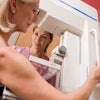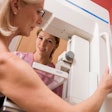The COVID-19 pandemic exacerbated health disparities in breast and colorectal cancer screening, a study published November 20 in JAMA Network Open found.
Researchers led by Aisha Lofters, MD, PhD, from Women’s College Hospital in Toronto, Ontario, found that the proportion of breast cancer screening use among people living in lower-income neighborhoods and immigrants decreased by nearly 10%. They also reported that people without family physicians had low screening uptake both before and after the pandemic.
“Policymakers should investigate the value of prioritizing and investing in improving access to team-based primary care for people who are immigrants and/or with limited income,” Lofters and colleagues wrote.
The early days of the COVID-19 pandemic in North America saw temporary closures of cancer screening services. This created a backlog that was expected to be tied to cancer diagnosis delays. For example, a previous report suggested a backlog of more than 300,000 screening mammograms.
The researchers noted that primary care physicians in Ontario were encouraged to consider prioritizing people who were underscreened or never screened for cancers when screening resumed. However, previous studies have indicated that the pandemic heightened existing health disparities such as impaired access to cancer screening services.
The Lofters team investigated whether changes in screening from before the pandemic to after varied for immigrants and for people with limited income in the Canadian province of Ontario. It examined the study population at two time points, late March 2019 and late March 2022.
The overall 2019 cohort consisted of 1,666,943 women eligible for breast screening, 3,918,225 women eligible for cervical screening, and 3,886,345 people eligible for colorectal screening.
The researchers found that the proportion of people up to date on screening in Ontario decreased for all cancers, with breast cancer screening having the largest decrease from 61.1% to 51.7% after the pandemic.
The researchers also used the beta estimate in their evaluation. This represents the percentage change in the rate difference versus the reference group. Here, negative values represent a larger decrease in screening after the pandemic while positive values represent a smaller decrease.
They also found that for breast cancer, the beta estimate for the lowest income quintile was -1.16 compared with the highest income quintile. For immigrant versus nonimmigrant, the beta estimate was -1.51. The researchers observed similar trends for colorectal cancer screening.
Additionally, the team reported that people with no identifiable family physician experienced the lowest screening rates both before and after the pandemic, moving from 11.3% in 2019 to 9.6% in 2022 up to date for breast cancer screening.
Finally, the team found that patients of interprofessional, team-based primary care models had significantly smaller reductions in beta estimates for all cancers examined in postpandemic screening, as well as higher uptake of screening in general compared with patients of other primary care models.
The study authors wrote that their results are in line with those from U.S.-based studies. They also highlighted that their study makes for a compelling argument for expanding access to interprofessional, team-based primary care as a method of increasing cancer-screening uptake.
“These efforts will require significant investment: although community health centers are designed for people experiencing marginalization, they currently serve less than 2% of the province’s population, and family health teams have traditionally been least available in geographic areas with the greatest need,” the authors wrote.
The full study can be found here.



















